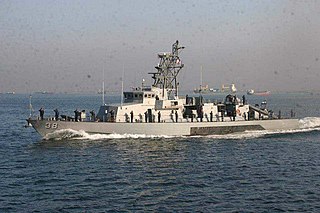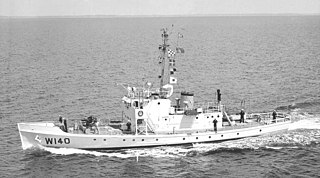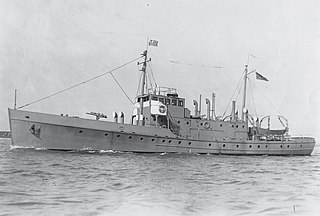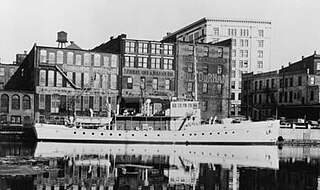
Fleet Week is a United States Navy, United States Marine Corps, and United States Coast Guard tradition in which active military ships recently deployed in overseas operations dock in a variety of major cities for one week. Once the ships dock, the crews can enter the city and visit its tourist attractions. At certain hours, the public can take a guided tour of the ships. Often, Fleet Week is accompanied by military demonstrations and air shows such as those provided by the Blue Angels.
The Medium Endurance Cutter or WMEC is a type of United States Coast Guard Cutter mainly consisting of the 270-foot (82 m) Famous- and 210-foot (64 m) Reliance-class cutters. These larger cutters are under control of Area Commands. These cutters have adequate accommodations for crew to live on board and can do 6 to 8 week patrols.

The Wind-class icebreakers were a line of diesel electric-powered icebreakers in service with the United States Navy, United States Coast Guard, Royal Canadian Navy, Canadian Coast Guard and Soviet Navy from 1944 through the late 1970s. They were very effective ships: all except Eastwind served at least thirty years, and Northwind served in the USCG continuously for forty-four years. Considered the most technologically advanced icebreakers in the world when first built, the Wind-class icebreakers were also heavily armed; the first operator of the class was the United States Coast Guard, which used the vessels for much-needed coastal patrol off Greenland during World War II. Three of the vessels of the class, Westwind, Southwind, and the first Northwind all went on to serve temporarily for the Soviet Union under the Lend-Lease program, while two others were built for the United States Navy and another was built for the Royal Canadian Navy; all eight vessels were eventually transferred to the United States Coast Guard and the Canadian Coast Guard.

USS Firebolt (PC-10) is the 10th member of the Cyclone class of coastal patrol boats of the United States Navy. She is a 174 ft (53 m) vessel with a crew of approximately 30 sailors, normally homeported at Naval Amphibious Base Little Creek, Norfolk, Virginia. Her armament includes two Mk38 chain guns, two Mk19 automatic grenade launchers, and two .50 in (12.7 mm) machine guns, as well as six Stinger missiles. She was laid down by Bollinger Shipyards on 17 September 1993, launched on 10 June 1994, commissioned into the Navy on 10 June 1995, and she was decommissioned on 23 February 2022.

USS Cyclone (PC-1) was the first of the Navy's Cyclone-class coastal patrol ships. As the lead ship of her class, Cyclone served as the test bed for this series of 14 vessels.

The Cyclone-class patrol ships are a class of United States Navy coastal patrol boats. Most of these ships were launched between 1992 and 1994. The primary mission of these ships is coastal patrol and interdiction surveillance, an important aspect of littoral operations outlined in the Navy's strategy, "Forward...From the Sea." These ships also provide full mission support for U.S. Navy SEALs and other special operations forces.

USS Tempest (PC-2) is the second of the Cyclone-class of United States Navy coastal patrol ships, named for various weather phenomena. She was transferred to the US Coast Guard as USCGC Tempest (WPC-2), on 1 October 2004, and placed in 'Commission Special' status until December 2005, when she was formally commissioned as a Coast Guard cutter. She was returned to the US Navy on 22 August 2008.

USS Monsoon (PC-4) is the fourth Cyclone-class patrol ship. Monsoon was laid down by Bollinger Shipyards, Lockport, Louisiana on 15 February 1992 and launched 10 October 1992. She was commissioned 22 January 1994 by the United States Navy. She was decommissioned 1 October 2004 and loaned to the United States Coast Guard as USCGC Monsoon (WPC-4). She was returned to the U.S. Navy on 22 August 2008.

USS Shamal (PC-13) is the thirteenth Cyclone-class patrol ship. Shamal was laid down 23 September 1994 by Bollinger Shipyards, Lockport, Louisiana and launched 3 March 1995. She was commissioned 27 January 1996. Decommissioned by the United States Navy 1 October 2004 and transferred to the United States Coast Guard and recommissioned the USCGC Shamal (WPC-13).

USS Tornado (PC-14) is the fourteenth and last Cyclone-class patrol ships, notable for being the only ship in the class designed with shaping features for signature management. She was laid down by Bollinger Shipyards, Lockport, Louisiana 25 August 1998 and launched 7 June 1999. She was commissioned by the United States Navy 24 June 2000, decommissioned 1 October 2004 and transferred to the United States Coast Guard as USCGC Tornado (WPC-14).

USS Cook Inlet (AVP-36) was a United States Navy Barnegat-class small seaplane tender in commission from 1944 to 1946. She tended seaplanes during World War II in the Pacific and earned one battle star for her service. After the war, she was transferred to the United States Coast Guard, and was in commission as the Coast Guard cutter USCGC Cook Inlet (WAVP-384), later WHEC-384, from 1949 to 1971. She saw service in the Vietnam War during her Coast Guard career, receiving two campaign stars for her operations during the conflict. Transferred to South Vietnam in 1971, she operated as the Republic of Vietnam Navy frigate RVNS Trần Quốc Toản (HQ-06) until South Vietnam's collapse in April 1975 at the end of the Vietnam War. She fled to the Philippines and in 1976 was transferred to the Philippine Navy, which never commissioned her, instead using her as a source of spare parts for her sister ships, the Andrés Bonifacio-class frigates, before discarding her in 1982.

The third USS Calypso (AG-35) was launched 6 January 1932 for the United States Coast Guard as USCGC Calypso (WPC-104) by the Bath Iron Works in Bath, Maine. She was initially stationed at San Diego, California and transferred to Baltimore, Maryland in 1938. She was transferred from the Coast Guard to the U.S. Navy on 17 May 1941 and commissioned the same day.

BRP General Mariano Alvarez (PS-38) is the lone ship of its class of coastal patrol ships in service with the Philippine Navy. She was the lead ship of the US Navy's Cyclone-class patrol ship prior to being transferred to the Philippine Navy.
The BRP Francisco Dagohoy (PF-10) was an Andrés Bonifacio-class frigate of the Philippine Navy that served from 1979 to 1985. She was one of six ex-United States Navy Barnegat-class small seaplane tenders and ex-United States Coast Guard Casco-class high endurance cutters received from the United States after the Vietnam War, two of which were cannibalized for spare parts without entering service. She and her other three sister ships were the largest Philippine Navy ships of their time.

USS Castle Rock (AVP-35) was a United States Navy Barnegat-class small seaplane tender in commission from 1944 to 1946 which saw service in the late months of World War II. After the war, she was in commission in the United States Coast Guard as the Coast Guard cutter USCGC Castle Rock (WAVP-383), later WHEC-383, from 1948 to 1971, seeing service in the Vietnam War during her Coast Guard career. Transferred to South Vietnam in 1971, she served in the Republic of Vietnam Navy as the frigate RVNS Trần Bình Trọng (HQ-05) and fought in the Battle of the Paracel Islands in 1974. When South Vietnam collapsed at the end of the Vietnam War in 1975, Trần Bình Trọng fled to the Philippines, where she served in the Philippine Navy from 1979 to 1985 as the frigate RPSFrancisco Dagohoy (PF-10).

The Active-class patrol boat was one of the most useful and long-lasting classes of United States Coast Guard cutters. Of the 35 built in the 1920s, 16 were still in service during the 1960s. The last to be decommissioned from active service was the Morris in 1970; the last in actual service was the Cuyahoga, which sank after an accidental collision in 1978.

USCGC Aspen (WLB-208) is the eighth cutter in the Juniper-class 225 ft (69 m) of seagoing buoy tenders. She is under the operational control of the Commander of the Eleventh U.S. Coast Guard District and is home-ported at Yerba Buena Island in San Francisco, California. Her primary area of responsibility is the coastal waters, river bars and high seas from the California–Oregon border to San Diego, California. Aspen conducts heavy lift aids-to-navigation operations, and law enforcement, homeland security, environmental pollution response, and search and rescue as directed.

USCGC Argo (WPC-100) was a Thetis-class patrol boat belonging to the United States Coast Guard launched on 12 November 1932 and commissioned on 6 January 1933.

USCGC Jackson was an Active-class cutter of the United States Coast Guard. She capsized in 1944, killing twenty one of forty crew members.

USCGC Antietam (WSC-128), later Bedloe was an Active-class cutter of the United States Coast Guard where she was commissioned from 1927 to 1944. She sank in 1944, killing 26 crewmembers.




















